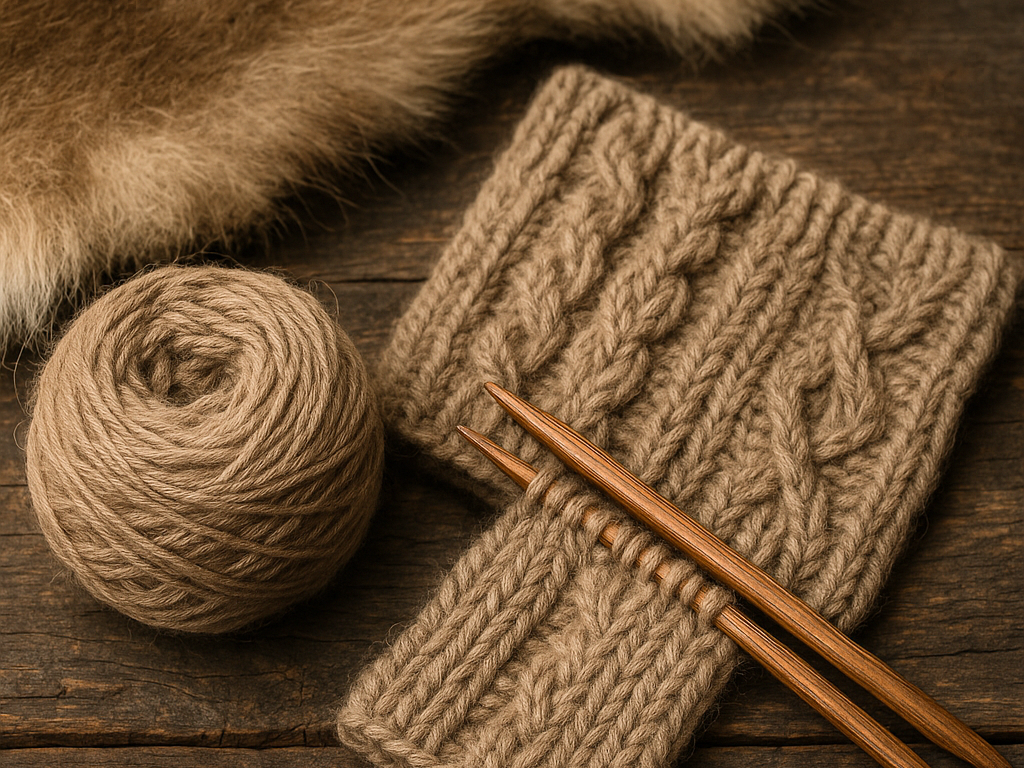#HistoryStitch: Inuit Knitting Patterns – Between Qiviuq, Spirituality & Colonial Misunderstandings

For centuries, Inuit communities lived across the Arctic – from Alaska to Greenland. In this harsh environment, clothing was not fashion but a matter of survival. Using sealskin, whale tissue, fat, and Qiviuq (the underwool of the musk ox), they developed textile traditions that blurred the lines between knitting, nålebinding, and sewing.
Yet these garments were more than protection against the cold – they carried spiritual meaning, cultural codes, and even colonial misinterpretations.
🏺 Archaeological Evidence
Findings from St. Lawrence Island (Kukulik Site, 1000–1400 AD) show textile fragments with hybrid construction: looped structures combined with fur and leather.
-
Some resemble nålebinding, a looping technique known in Scandinavia.
-
Others clearly display rows of stitches, closer to knitting.
-
Inuit garments often combined fiber and hide – clothing as true hybrid work.
👉 These finds show that Inuit textiles were not just clothing but archaeological archives of daily life.
🦭 Materials of the Arctic
Qiviuq [see as well #FunFact: Qiviut - The Golden Fleece of the Arctic]
-
Eight times warmer than sheep's wool, extremely soft and light.
-
Collected during molting, very labor-intensive.
-
Exported to Europe in the 19th century → became a luxury fiber for elites.
-
Today marketed as "Cashmere of the Arctic" – but stripped of its original spiritual meaning.
Sealskin
-
Provided warmth and water resistance.
-
Reinforced knitted pieces and symbolized the deep connection to hunting culture.
Whale fat & hide
-
18th-century missionary reports describe water-resistant whale-fat-based linings in boots and mittens.
-
Almost forgotten today, but once an important resource.
📜 Spirituality in Stitches
Some designs were reserved for shamans only. Clothing could act as a spiritual tool, offering protection, much like drums or masks. Missionary writings acknowledge these motifs but often misunderstood their function.
Garments were thus protection against both the cold and the unseen.
Zigzag lines = ice cracks, waves.
-
Circles = sun & moon.
-
Slanted motifs = hunting spears or migrating geese.
👉 Patterns = not decorative, but symbols and stories.
🧶 Knitting or Nålebinding?
Scholars still debate:
-
Many fragments resemble nålebinding with looping and knot-like stitches.
-
Others show knitting structures, nearly identical to European work.
-
Contacts with Norse settlers in Greenland suggest cultural exchange – Inuit and Viking textile knowledge may have influenced each other.
👉 Inuit textiles might represent a missing link between Arctic survival craft and European knitting traditions.
🌍 Colonial Influences & Misunderstandings
When European whalers and missionaries arrived (17th–18th century), they brought wool, metal needles, and written patterns. Inuit women adapted them – but always in their own cultural logic.
-
Hybrids emerged: European-style knitting worked in Qiviuq and sealskin.
-
Missionaries dismissed them as "primitive knitting".
-
Only in the 20th century did ethnographers begin to value these textiles as cultural treasures.
🪶 From the Arctic to the Modern World
Today, Inuit textile knowledge is being revived:
-
Workshops in Nunavut and Greenland teach Qiviuq processing to younger generations.
-
Museums digitize textiles to preserve designs.
-
Indigenous designers reintroduce patterns into modern fashion, connecting style with identity.
🐋 My Takeaway
Inuit knitting traditions are more than craft – they are cultural archives. Archaeology, oral history, and colonial records reveal that every stitch carries survival, spirituality, and identity. By documenting and reviving these nearly forgotten techniques, Inuit communities preserve not just a skill, but a worldview knitted into fabric.
👉 Would you like to try a traditional Qiviuq-inspired pattern?
Share your thoughts in our Facebook Group – history lives on when we pass it along together.
#strickenimtrend #maschenmitliebe #historystitch #inuitknitting #qiviuq
The Inuit remind us that textiles are climate, spirit, and culture woven together. Each stitch is a fragment of history – and deserves to be preserved.
Warmly,
Kathrin ☀️🧶
Want to dive deeper into the world of stitches?
Explore my patterns, browse the blog, or join our community!
